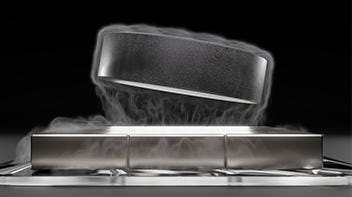When researchers claimed to discover a room-temperature superconductor called LK-99, it set off a viral race to replicate their findings in both professional and amateur labs in pursuit of a potentially revolutionary materials science breakthrough.
By Alex Knapp, Forbes Staff
In late July, Andrew McCalip started livestreaming on Twitch, which by itself wasn’t unusual. What was, however, were the number of people watching him–over 16,000, catapulting him into the top 5 streams on the popular site. For someone who had fewer than 600 followers at the time, it was quite an achievement. Especially since he wasn’t playing a video game–he was just mixing chemical powders and heating them up to over 1300 degrees Fahrenheit, grinding down the results and mixing them and heating them again–all in an attempt to replicate the recipe for making a substance called LK-99.
“We started the livestream as a joke, really,” McCalip, an engineer at the startup Varda Space Industries, told Forbes. “What could be more boring than watching our furnace operate?”
Twitch fans weren’t the only ones suddenly obsessed with the substance, samples of which were shown to be magnetically levitating in scientists’ videos. As materials scientists and hobbyists alike rushed to recreate LK-99 in their labs, tech luminaries like Spotify founder Daniel Ek and “SPAC King” Chamath Palihapitiya were publicly touting the latest developments on social media, along with hordes of science and tech enthusiasts.
What had caught the attention of the internet public were the extraordinary claims surrounding LK-99, which had been described in a preliminary paper from a group of researchers at Korea’s Quantum Energy Research Centre as “the first room-temperature ambient-pressure superconductor.” If verified, this substance would have had the potential to revolutionize electronics components and make possible products that otherwise couldn’t be built.
While the jury in the court of scientific opinion ultimately won’t deliver an official verdict for months as scientists replicate the substance, test it and subject their findings to peer review, early experiments have convinced most researchers in the field that LK-99 isn’t a superconductor. But the internet’s momentary obsession with the material highlights a real optimism towards the discovery of a technology that could move a wide swathe of industries forward.
Superconducting’s Revolutionary Possibilities
To better get a handle on what caused all the excitement, let’s take a step back to the basics. A conductor of electricity is one where electrons flow fairly freely. Conductors are typically metals, like copper, gold and silver. But they’re not perfect — the electrons don’t flow seamlessly through a conductor. They move more like a crowd of people all trying to get out of a stadium after a game. Even when there’s lots of room, they stop, start, bump into each other and sometimes slow down. In electric circuits, that’s called resistance. For electrons, all that resistance generates heat, which is why your computer comes equipped with fans to cool it down.
Superconductors, on the other hand, enable a near-perfect flow of electrons without resistance, so they don’t generate heat. When superconductors are used to make electromagnets, they are both compact and powerful–their invention in the 1970s made MRI imaging possible. But there’s a catch: they only exhibit zero resistance at extremely cold temperatures, which for most of them is near absolute zero. That makes them impractical for use in most situations. And to keep them running for applications like the MRI at your hospital, or quantum computers, they have to be cooled down with liquid helium, which is a bulky and expensive process.
This is why the prospect of a room-temperature superconductor that operates at normal atmospheric pressures is exciting: It could make electric power generation and distribution significantly more efficient. Right now, the Department of Energy estimates that about 5% of electricity generated in the country is lost as it moves from power stations to customers, an amount worth about $65 billion. But that’s not the only advantage to room-temperature superconductors: an August report from investment bank Jefferies cited applications like cheaper MRI machines and improved accessibility for quantum computers; reduced costs for the magnets used to achieve nuclear fusion, making it more viable for commercialization; and the use of superconductors’ magnetic levitation processes to build faster trains.
Getting rid of the resistance from normal electric conductors has day-to-day practical applications, too. “One of the major costs of copper-based electronics is not the cost of the power lost through resistance, but the cost of removing the resulting heat,” Casey Handmer, a physicist who founded green energy startup Terraform, told Forbes in an email. “All high power applications including electric motors, battery chargers, power converters, and particularly computers, could potentially greatly improve their power density and performance with the use of room temperature superconductors.”
Josh Wolfe, founder of venture capitalist firm Lux, shared similar sentiments, adding that he thinks “the bigger prospect is once a new capability exists and people can tinker with it, what creative ideas engineers will conjure that haven’t even been imagined yet.”
Which is not to say that a room temperature superconductor would make this happen overnight. “Going from that to something that’s going to replace copper is a really big technological job,” said Prineha Narang, a professor at UCLA who researches new materials. It’s not just the logistics to consider; copper is also extremely cheap. Anything that’s going to replace it needs to have some clear cost advantages. Part of the allure of LK-99 may be that it was made from lead, copper and phosphorus, materials that are relatively inexpensive and abundant.
The Viral Alchemy Of LK-99
This isn’t the first time that claims about a superconducting material have circulated on the internet, said Inna Vishik, a physicist at UC Davis. “They pop up every couple years.”
If that’s the case, why did LK-99 cause such viral interest? In part, Vishik said, it may be because it was fairly easy to replicate. A lot of labs had many of the salient materials on hand, which she said may have been a factor in the explosive interest. “It’s relatively low-cost and low-tech,” she said.
Another factor, added David Larbalestier, the chief materials scientist at the National High Magnetic Field Laboratory, is the fact that the initial paper wasn’t obviously a hoax or mistake. “You know, some guys made a discovery. They clearly didn’t understand completely what it was. But they took an optimistic view, and then presented a good lock of evidence so that people could look at it and judge for themselves. It’s not bullshit. It’s not obfuscation.”
These two factors created interest, especially when combined with the fact that scientists don’t have a good way to figure out whether a material can become a superconductor. “Superconductors are very difficult to predict,” said Leslie Schoop, a chemistry professor at Princeton, whose lab replicated LK-99 but did not find it had superconducting properties. “They sometimes come really out of left field.”
The virality of the experiment also helped fuel interest among scientists. Schoop said that when she read the first paper, she didn’t think LK-99 was a superconducting material, but found herself compelled to replicate the material in her own lab because of the level of interest.
“So many people texted me about it that I felt like I needed to do it,” she told Forbes. “So I could make a better comment than just commenting on other people’s data.”
That replication effort, along with others that were published by researchers at the CSIR National Physical Laboratory in India and the Beijing National Laboratory for Condensed Matter Physics, all found that while LK-99 superficially does show some interesting magnetic properties, as well as reduced electrical resistance in certain samples, it likely doesn’t have any of the properties that make a superconductor. A thorough analysis published earlier this week from the Max Planck Institute for Solid State Research suggests that what caused the appearance of superconductivity were already well-understood mechanics in the copper caused by the method used to create LK-99.
“I don’t think this is a path towards superconductivity, but there is something interesting there,” said Vishik. Many of the other scientists who spoke to Forbes expressed similar sentiments.
One bright side to the viral public interest in LK-99 is that it sparked curiosity in the field, said Sinead Griffin, a physicist at the Lawrence Berkeley National Lab, whose computer simulation of some of LK-99’s properties went viral on Twitter. “I’ve already actually had a few emails from high school students asking me questions,” she said. “Seeing those has been really fun.”
As far as McCalip is concerned, his work is done, too. He was successful in replicating LK-99 based on the formula in the paper and delivered it to a lab at the University of Southern California. That lab found that the material he created, like those replicated in other labs, didn’t show any superconducting properties either. But after so much interest in his livestream experiment, he, too, is excited about the general enthusiasm for science that LK-99 seems to have sparked, especially for the space company he works for.
“One of the big value-adds that we’ve seen is that hundreds of people have reached out with resumes that have been fantastic,” he said. “So if nothing else, this was great exposure and now we have a much bigger pipeline of talent aware of our company. And so that’s what I’m thankful for. It was a happy accident.”
MORE FROM FORBES
Read the full article here





